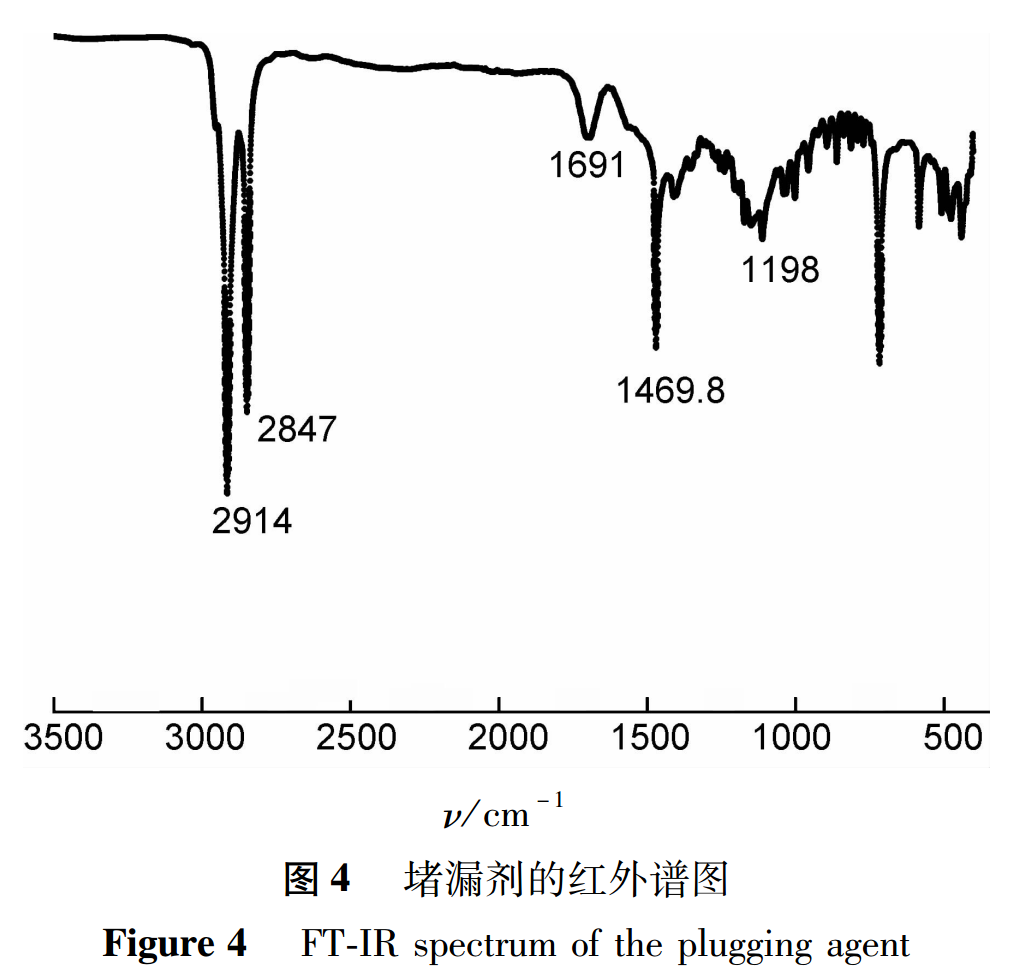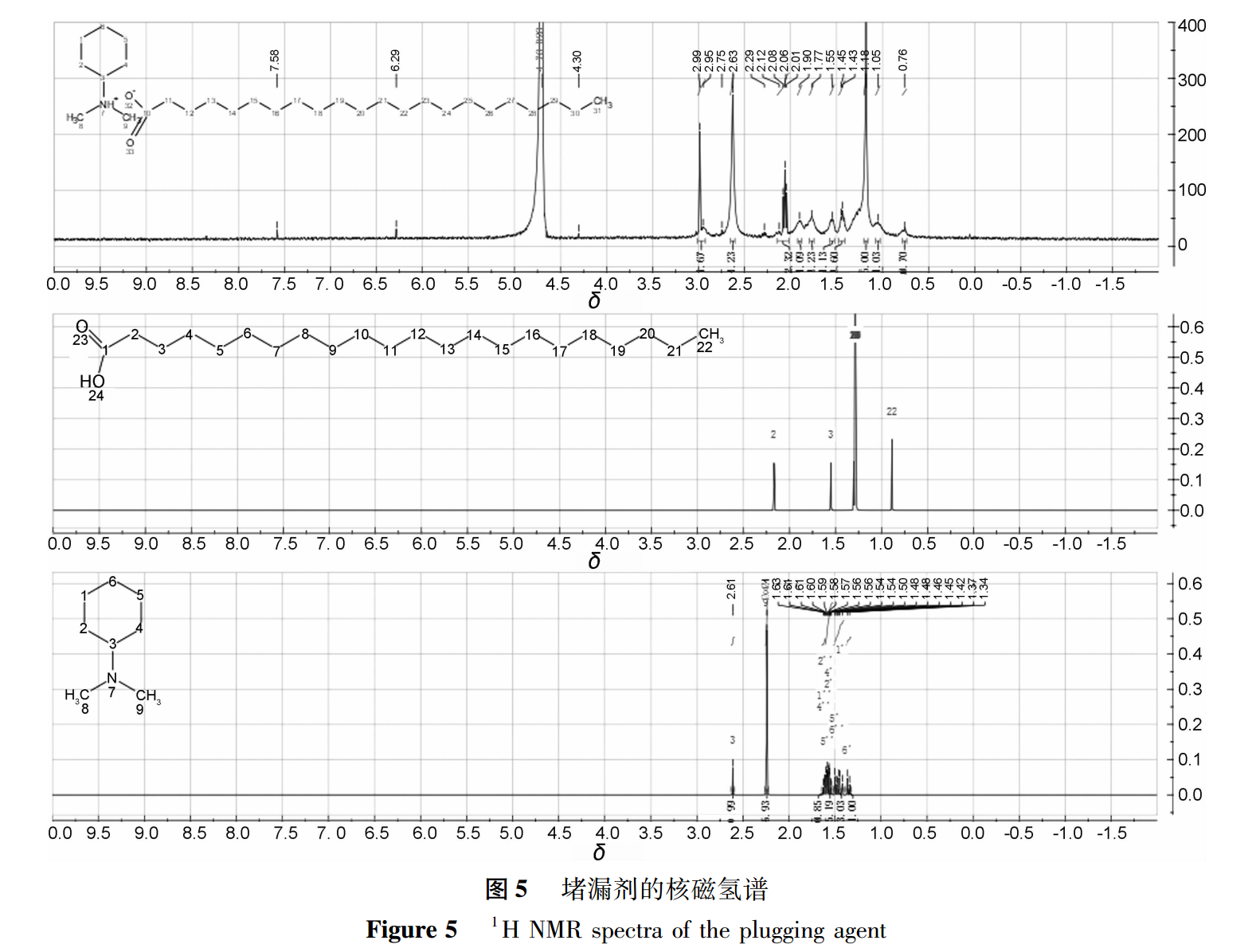Synthesis and Evaluation of a New Temperature Responsive Worm like Micellar Plugging Agent (Part 1)
Abstract
In response to typical defects such as poor slurry retention and poor solidification selectivity in sealing large-scale cracks or caves, as well as damage to reservoirs caused by cement slurry, TDL, a plugging agent, was synthesized using N, N-dimethylcyclohexylamine (DMCHA) and succinic acid (BA) based on the theory of surface active agent molecular association worm like micelles. The structure of the synthesized plugging agent was characterized using Fourier transform infrared spectroscopy and nuclear magnetic resonance spectroscopy;TDL is combined with kerosene to form a plugging working fluid, which undergoes phase to phase self-assembly upon contact with water. A small angle X-ray scattering instrument (SAXS) and a designed inverted pressure device are used to evaluate the wall stability and pressure bearing capacity of the plugging system.The results showed that both infrared spectroscopy and nuclear magnetic hydrogen spectroscopy revealed the characteristic structure of R-COO-NH+(CH3) 2-R', and there were no residues in the raw materials; The plugging system forms a liquid crystal layered gel structure with a layer spacing of 123.20Å between the formation water and plugging agent interface. The pressure bearing pressure of the plugging agent per unit mass reaches 78 MPa, and the stability time under pressure exceeds 30 days;The sealing system is stable when the temperature is below 65℃, and has good fluidity when it is above 80℃, but loses its sealing effect.The new responsive worm like micelle plugging agent has good plugging performance for medium and low temperature leakage layers, and can also be used as a pre plug for cement plugging to cope with malignant leakage.
Large scale fractures or caves and other malignant leakage have always been prominent challenges in the drilling process, especially in salt mining with shallow burial depth, highly developed fractures, and low pressure bearing capacity.Most of the salt mines in China are buried below 3000m and are mined using the drilling water-soluble method. The gravity differentiation of salt brine and the hydraulic connection of the roof are characteristic reasons for the loss of drilling or spraying near the salt layer, which seriously restricts the smooth progress of drilling construction and affects the overall development and utilization of salt mines. It is also prone to complex geological disasters such as large-scale underground collapse and surface deformation.In response to such situations, most current mining technologies have borrowed some plugging methods from oil and gas drilling.Yang Yun et al. implemented inflatable drilling and cement sealing for malignant leakage in the Longdong area. Although inflatable drilling technology solved the problem of leakage in the well in a short time and at a low cost, it brought strict requirements for formation pressure, wellbore stability, and formation water content;Wen Hongbin's use of matching plugging and sealing equipment for casing completion of different sizes in lateral drilling layer by layer mining has good economic benefits, but it is only suitable for well sections where the leakage layer has been accurately identified;Tang Ming and others used expansion tubing as a technical casing to seal complex formations based on geological requirements and well conditions. They carried out drilling and production technology modifications on complex formations from an equipment perspective, which can meet the requirements of drilling and subsequent unconventional small hole drilling. However, the high cost of expansion tubing limits the promotion of this technology;Wang Jintao et al. and Chen Defei et al. proposed that the key to using gas drilling to seal water formations is to first isolate, then block the water, and then unseal it. The current development trend is the use of water blocking agents with certain pressure bearing capacity and corresponding processes.
The use of cement can achieve long-term high-strength sealing of cracks, and cement modified with magnesium phosphate or resin can even achieve sealing of ultra deep formations and ultrafine cracks. However, due to the complexity of cracks, it is difficult to effectively seal them by directly injecting cement. At the same time, the injected cement is prone to continuous flow along the cracks, which can lead to safety accidents such as mud leakage, sealing failure, and contamination of the bottom layer.Therefore, it is particularly important to achieve effective sealing of cracks by cement slurry, control the flow of slurry, and reduce leakage.The sealing agent is injected into the formation and comes into contact with the formation water in the fracture. The effective components of the sealing agent form a stable sealing wall with a certain strength between the formation water and the sealing agent interface, achieving the sealing of the fracture channel.After injecting cement slurry, it does not flow towards deeper cracks when encountering a stable sealing wall, but only gathers and solidifies on the stable sealing wall, achieving effective sealing of cracks by cement slurry. The selection of sealing agent is the key to achieving water contact thixotropic sealing technology.Surfactants can exist stably at the oil-water interface, but most of the common surfactants in the water and oil phases will make the system become a lotion system, that is, micelles are formed in the water or oil phase to realize oil-water mixing.LANG et al. proposed a nano block copolymer, which realized the transition from micelle to gel by changing the concentration of nano block copolymer.XIA et al. proposed a pseudo tetramer surfactant that self assembles to form a viscoelastic fluid, namely worm like micelles.
This article chooses to use acid amine composite surfactants, which can dissolve in water or oil phases, and spontaneously aggregate towards the water oil interface, forming worm like micelles through self-assembly and the water and oil at the interface, thus achieving the purpose of interface sealing (Figure 1).
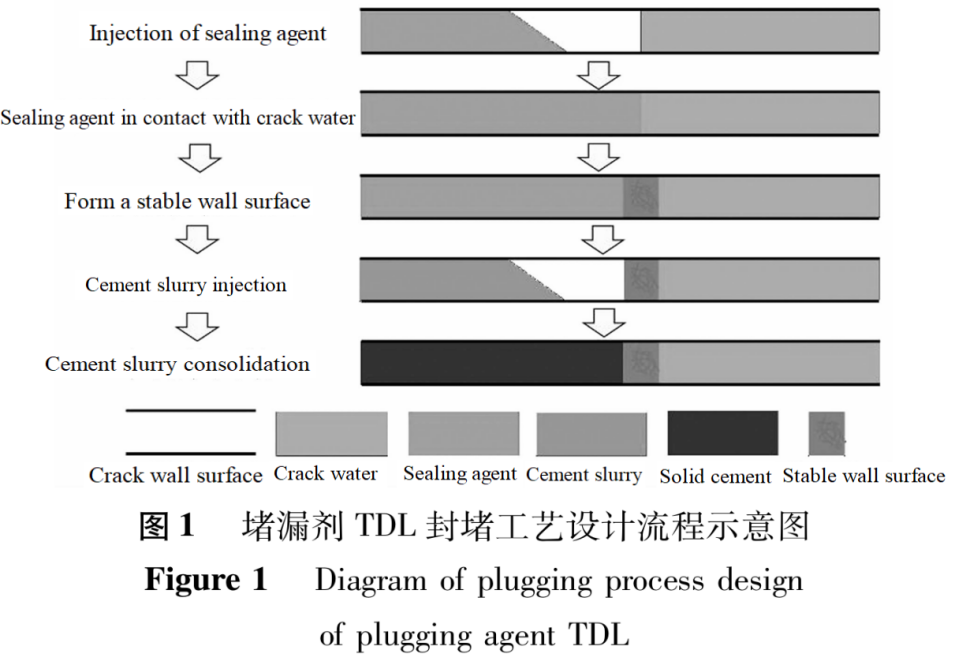
1. Experimental Section
1.1 Instruments and Reagents
Is50 Fourier Transform Infrared Spectrometer (KBr pellet), Thermo Fisher Scientific, USA;
AV 400 nuclear magnetic resonance instrument (solvent D2O, internal standard TMS), Bruker GmbH, Germany;
VANTEC-2000 Small Angle X-ray Scattering Instrument, Bruker GmbH, Germany.
N,N-Dimethylcyclohexylamine (DMCHA, DM), behenic acid (BA), kerosene, analytical grade, Chengdu Kelon Reagent Co., Ltd;
Nitrogen (N2, purity>99.90%), Chengdu Jingli Gas Company;
Self made deionized water;
All other reagents used are analytical grade.
1.2 Synthesis and Characterization
(1) Synthesis of Plugging Agent TDL
The interface gelation factor with surface activity is achieved through rational molecular structure design, such as introducing hydroxyl groups to solidify the solvent as a whole, and introducing long carbon chains and active groups to achieve interface solidification of the solvent water interface.DM, as a common organic tertiary amine, can react with conventional organic acids to generate acid amine ion pairs. Under certain external stimuli, the ion pairs undergo dissociation and generation.In the research of MA et al., DM can interact with oleic acid and exhibit a dual CO2 response phenomenon in the sodium oleate system.Although oleic acid has a long carbon chain, it has strong emulsifying properties and is greatly affected by acidic and alkaline environments. Therefore, oleic acid is not selected as a raw material for plugging agents.BA is similar to oleic acid in that it has a long carbon chain and can interact with DM to form acid amine ion pairs. It also exists in solid form at lower temperatures, which can meet the requirements of a certain temperature environment.Therefore, add equal amounts of DM and BA to a 250mL round bottom flask, stir and introduce N2 for 5 minutes, then heat up to 80℃ and react for 24 hours. After the reaction, TDL, a white solid product, was obtained as a plugging agent at room temperature (Figure 2).
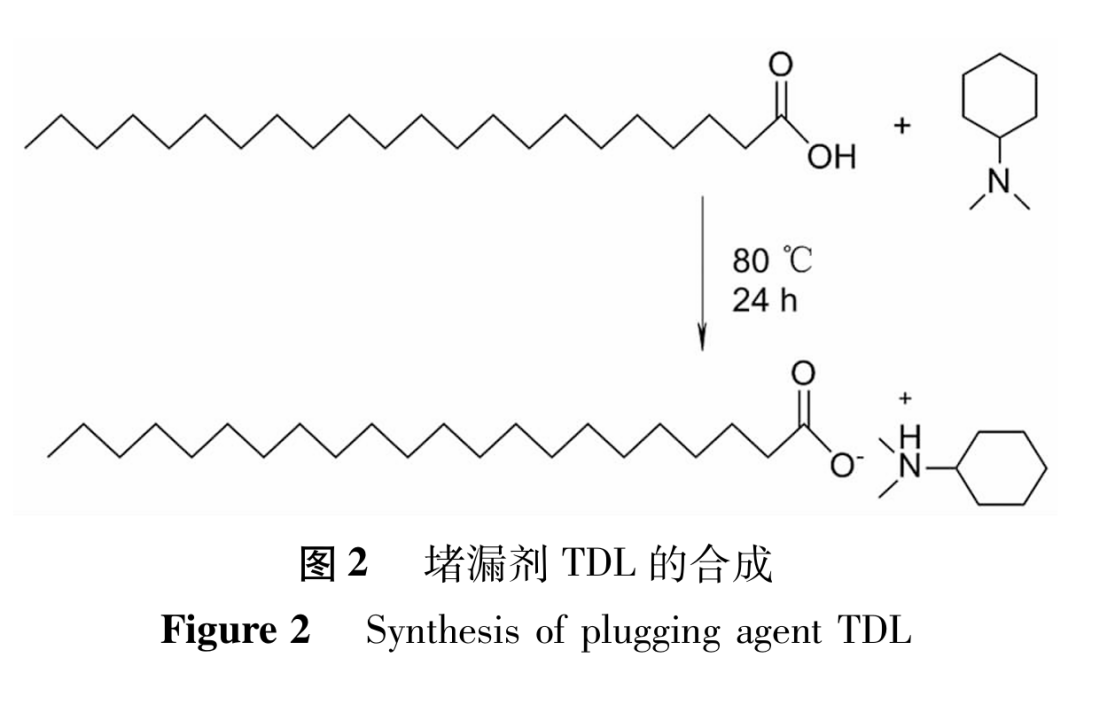
(2) Characterization of Plugging Agent TDL
Grind a small amount of solid plugging agent TDL and KBr together and press them into tablets. Use a Fourier transform infrared spectrometer to perform infrared absorption spectroscopy (FT-IR) testing at room temperature; Dissolve a small amount of solid blocking agent in heavy water (D2O) and perform 1H NMR testing on the blocking agent using a nuclear magnetic resonance instrument.
1.3 Performance Testing
(1) Formation and characterization of stable sealing wall surface
Add the plugging agent working fluid mixed with simulated oil and plugging agent into a graduated cylinder filled with water, and observe the formation of a stable plugging wall surface. Remove the stable sealing wall and characterize it using a small angle X-ray scattering instrument (SAXS).
(2) Evaluation of Sealing Pressure Performance
During the process of observing the formation of a stable sealing wall, invert the measuring cylinder and evaluate the gravitational pressure bearing capacity of the stable sealing wall. Using a connecting device, add water and sealing agent working fluid on both sides of the connector (Figure 3), and observe the formation of stable sealing walls in small-sized connected conduits.Add water or simulate oil to one side, simulate the pressure changes caused by the fluid volume between the formation fractures, and evaluate the pressure bearing capacity of the stable sealing wall.Add 10g, 50g, and 100g of water to containers with different diameters, such as syringe (ψ=4mm), graduated cylinder 1 (50mL, ψ=21mm), and graduated cylinder 2 (100mL, ψ=26mm), and then add 10mL of simulated oil with a concentration of 5% (mass fraction, the same below) of sealing agent.After the stable sealing wall is formed, invert the measuring cylinder and observe the static pressure bearing capacity of the stable sealing wall, and evaluate the unit area pressure bearing capacity of the stable sealing wall.
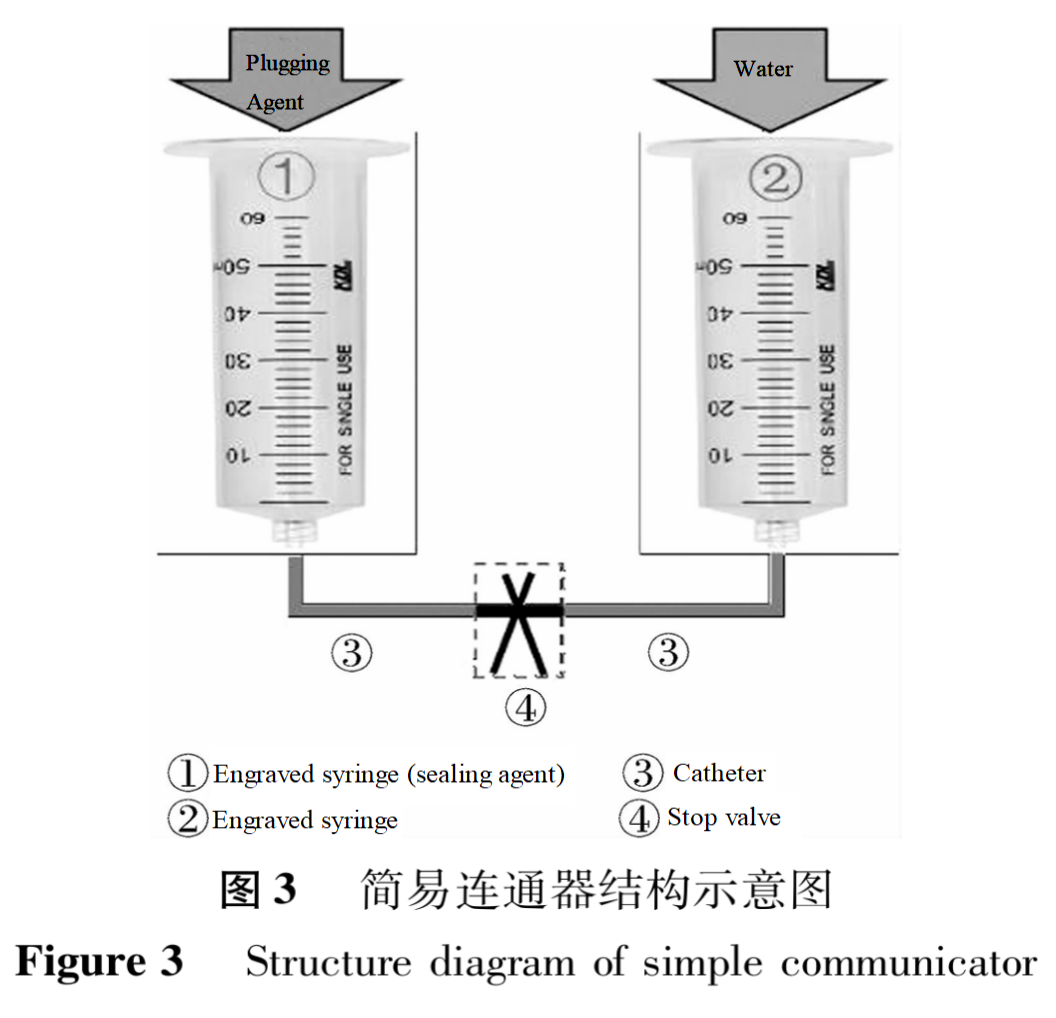
(3) The influence of temperature on the stable sealing wall surface
Place the stable sealing wall formed at room temperature in a water bath at different temperatures, heat or cool for 30 minutes, and observe the effect of temperature on the stability of the sealing wall. Heat at a higher temperature to make the stable sealing wall lose its stability. Place it in a refrigerator at 2-4℃ for 30 minutes, and then observe the stability of the stable sealing wall.
2. Results and Discussion
2.1 Structural Characterization of Plugging Agent TDL
In the infrared spectrum of the plugging agent (Figure 4), 1691cm-1 is the stretching vibration peak of C=O, 1198cm-1 is the stretching vibration peak of tertiary amine C-N, 1469cm-1 is the bending vibration peak of C-H plane, and 2847cm-1 and 2914cm-1 are the stretching vibration peaks of C-H.In the nuclear magnetic resonance hydrogen spectrum of the plugging agent TDL (Figure 5), the 1H NMR (400MHz, D2O) data is: δ 7.58,6.29,4.71,4.30,2.99,2.95,2.75,2.63,2.29,2.12,2.08,2.06,2.04,1.90,1.77,1.55,1.45,1.43,1.18,1.05,0.76.The characteristic peak of methyl H appearing in the raw material DM at δ 2.24 has changed to δ 2.29 in the product, which is due to the strong electron withdrawing effect of the hydroxyl group O losing H on the adjacent N in the raw material DM, causing the methyl H to move towards a higher field;The hydroxyl H characteristic peak of raw material BA at 11.87 ppm does not appear in the NMR data of the plugging agent, confirming the absence of free hydroxyl groups in the product. Therefore, both infrared spectroscopy and nuclear magnetic hydrogen spectroscopy data indicate that the blocking agent has been successfully synthesized and there are no residual raw materials.
